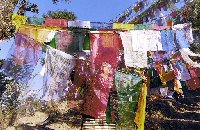'Little Lhasa': Tibetan spirit endures in
the Dalai Lama's Indian home
![]() |
 |
|
| Prayer flags flutter
on the hillside below the Dalai Lamas's house in the northern Indian town of Dharamsala,
home to Tibetans in exile. |
|
![]() |
DHARAMSALA,
India - The Tibetan faithful hit the trail at sunrise, walking clockwise below the Dalai
Lama's house, spinning prayer wheels that send mantras by the millions into the crisp
mountain air.
Among them is a
stooped, wizened monk who spent years in Chinese prisons before fleeing over the Himalayas
to this place of refuge. The monk told the Dalai Lama, the Tibetan Buddhist spiritual
leader, that he faced danger a few times during his imprisonment.
"What kind of
danger?" the Dalai Lama asked.
"Danger of
losing my compassion toward the Chinese," the monk said.
A taste of old
Tibet
Politics and
religion are entwined here in the small town of Dharamsala in north India. Sometimes
nicknamed "Little Lhasa" (after the Tibetan capital of Lhasa), Dharamsala clings
to steep Himalayan foothills just as its 8,000 exiled Tibetan residents cling to hopes of
returning to their Chinese-controlled homeland.

|
|
Dharamsala, which
clings to the Himalayan foothills, blends Indian and Tibetan cultures and is home to the
Tibetan government-in-exile. |
![]()
|
Cultures converge
in Dharamsala: Western tourists stroll past Indian sacred cows and Buddhist monks, hoping
for a glimpse of His Holiness or at least American actor Richard Gere or another celebrity
devotee.
Dharamsala is the
focus of the worldwide exiled Tibetan community. Like a space capsule in a science-fiction
movie, the town contains the crucial ingredients of a threatened civilization, preserving
them in hopes of eventual return to the homeland.
This outpost 250
miles north of New Delhi transports visitors to the Tibet of a bygone era before Mao
Tse-tung's troops "liberated" the feudal state on the world's rooftop, causing
the Dalai Lama to flee. The low chanting of maroon-robed monks mingles with fumes from
yak-butter candles, spreading a mystical calm. Refugee children study their language and
history in a school designed to perpetuate Tibetan traditions.
"In their
minds," the Dalai Lama says, "the Tibetan spirit is very, very alive."
A spirit of its
own
Yet just as
Tibet was never the Shangri-La depicted in Hollywood, neither is Dharamsala a replica of
Lhasa, Tibet's capital. The Dalai Lama has democratized Tibet's government in exile, whose
parliament meets here in simple quarters built to seem temporary. At less than 6,000 feet,
Dharamsala's altitude is a far cry from Lhasa's lofty heights and a good deal easier on
the lungs. And relations between Tibetans and Indians are downright friendly compared to
Sino-Tibetan hostilities back home.
Visitors won't find
the breathtaking views here of the Potala Palace or the Jokhang temple, Lhasa's main
attractions. But they can see Tibetan Buddhism free from repression; visit the Nechung
Monastery, where the Dalai Lama periodically consults an oracle; and, with the right
timing, attend a public audience with His Holiness. (Register a few days ahead at the
Branch Security Office, near Hotel Tibet.)
Two worlds
By visiting
this country within a country, travelers can experience something of both Tibet and India.
The pine-forested hills offer a nice respite from India's hot, noisy cities.

|
|
The Dalai Lama, the
Tibetan spiritual leader, smells the flowers in his garden in Dharamsala. |
|